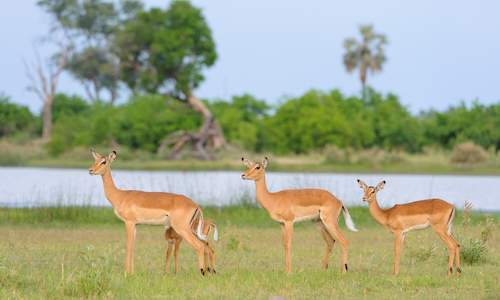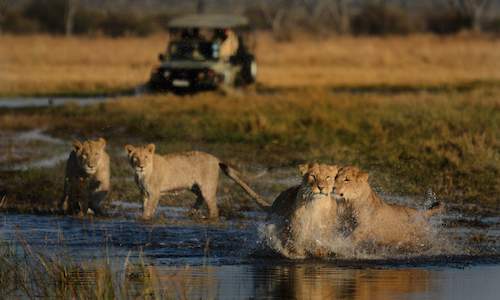
Introduction
The Savuti (also spelt Savute) area borders the Delta to the west and Chobe National Park to the east and is one of Africa's best known big game areas. Savuti is a place of enchantment, of beauty, and boasts one of the greatest concentrations of animals in Southern Africa.Savuti Channel
Savuti is famous for its mysterious and fascinating channel. It runs a distance of 100 kilometers from the Chobe River, through a gap in the sand ridge, to the Mababe Depression. Falling only approximately 18 meters, this channel brings water from the Chobe to Mababe, creating a small marsh where it enters the Depression. Flowing in Livingstone's time, the channel was dry in 1880, and remained dry for about 70 years. It flooded again in 1957. Savuti Marsh has been dry for the past 18 years.Wildlife
Savuti is famous for its predators, especially its resident lion and spotted hyena populations. Only 38 kilometers northwest of Savuti and off the main tourist track lies Botswana's best kept secret: Linyanti and the western reaches of the Savuti Channel.The Linyanti and upper Savuti areas are among the most beautiful in Botswana. The game-viewing can be exceptional, and the wide variety of activities make this an area not be missed. Linyanti hosts large herds of buffalo, zebra and elephant. Because this area is a private game reserve, the vehicle concentrations are very low and the wilderness experience is one of the best in Africa.Birdlife
Large secretary birds and kori bustards can be sighted strutting around the Savuti marsh and small redbilled francolins is known for its noisiness. Interesting summer migrants and water birds include Abdim's storks, carmine bee eaters and even fish eagles. Little quelea finches are quite a spectacle as they gather in thousands. They are in abundance in April when a single flock could contain tens of thousands of these small birds.Vegetation
The Savuti area is mainly characterised by Camelthorn (Acacia erioloba) sandveld, Silver Terminalia (Terminalia sericea) sandveld, scrub savanna, and mopane veld. Savuti's almost desert-like landscape with a scorching sun, loose, hot sand, animals escaping the heat by clumping together in the limited available shade, and elephants lining up to get to the water supply, offer a wildlife experience you won't easily forget.Geology
This desolate, harsh landscape was once submerged beneath an enormous inland sea. Geologically the five main features of Savuti (namely the Magwikhwe Sand Ridge, the Mababe Depression, the Savuti Marsh with its dead trees, the Rocky Outcrops, and the Savuti Channel) are all intricately linked in the most fascinating manner.People still speculate as to how this once massive lake received its waters. The most popular explanation is that once the Upper Zambezi, the Chobe, and the Okavango rivers flowed together, across the north of Botswana and down to the sea via the Limpopo.A gentle warping of the Earth's crust dammed this flow to create a vast lake. In time, however, further crustal movement caused these rivers to find a new route to the sea. The direction of these rivers changed by faulting; the Upper Zambezi and the Chobe turned to the northeast and, after plunging over the Victoria Falls, joined what is now the Middle Zambezi.Trapped by an emerging rift valley, the Okavango bled its waters into the sand to form the delta. A changing climate which reduced rainfall and brought a return of almost desert-like conditions caused the super-lake to be cut off from its supplies of water, and dry up and vanished.Activities
DumaTau offers day and night game drives along the Linyanti and Savuti as well as short nature walks. The camp's boat allows guests access to the waterways to observe the Hippos at close range (water levels permitting). There are a number of hides in the area which give guests the opportunity to observe and photograph animals close up in their natural environment without disturbance.When to Visit Savuti
Rainy season: Rains arrive from November to April, at which time the animals make their way to pastures rich in new grass. Sometime in November or December thousands of zebras migrate from the Linyanti in the north and move south through Savuti to the grasslands of the Mababe Depression. In February they start heading northwards again. Humidity and heat is high.
Dry season: From May to October the water pans dry up and the animals are attracted to three artificial waterholes. September and October can be extremely hot but game viewing is very rewarding as predators are concentrated around the waterholes.
Location
Savuti area is located in southern Africa. It borders the Delta to the west and Chobe National Park to the east.Savuti Accommodation
Our Botswana Destination Specialists will tailor-make a safari package just for you including the Savuti accommodation style of your choice.

 Savute is tucked away within the spectacular Chobe National Park in Botswana, and stretches all along the northern boundaries of the park...
Savute is tucked away within the spectacular Chobe National Park in Botswana, and stretches all along the northern boundaries of the park... Savute in the Chobe National Park in Botswana is a place that has undergone great change over the past two years, from a semi arid wet seaso...
Savute in the Chobe National Park in Botswana is a place that has undergone great change over the past two years, from a semi arid wet seaso...